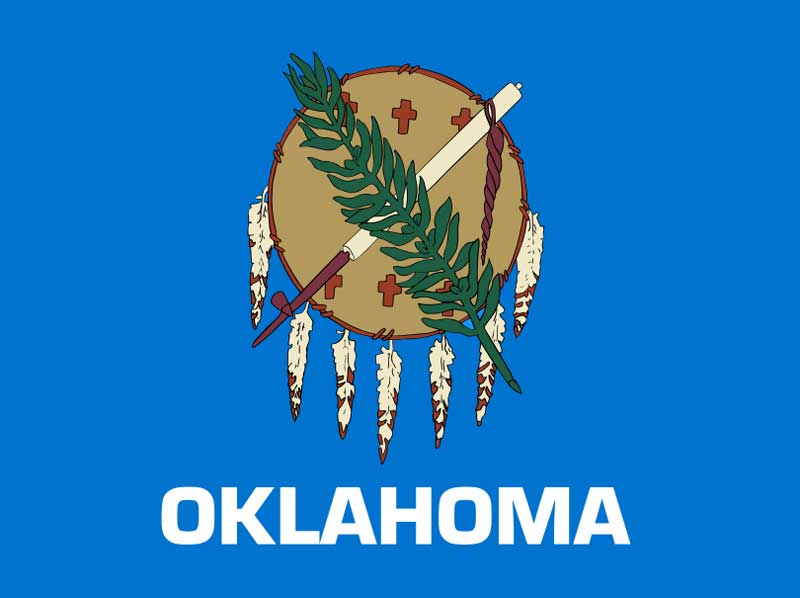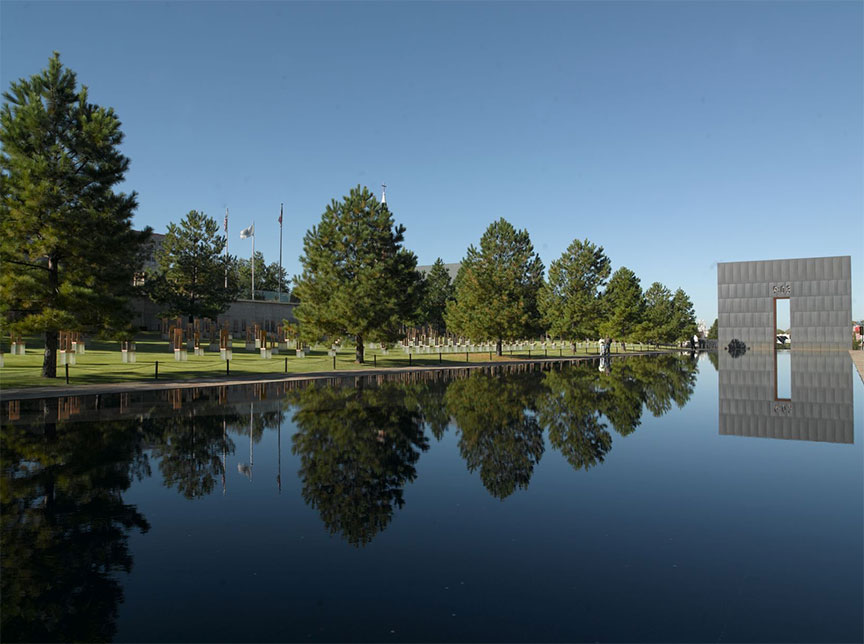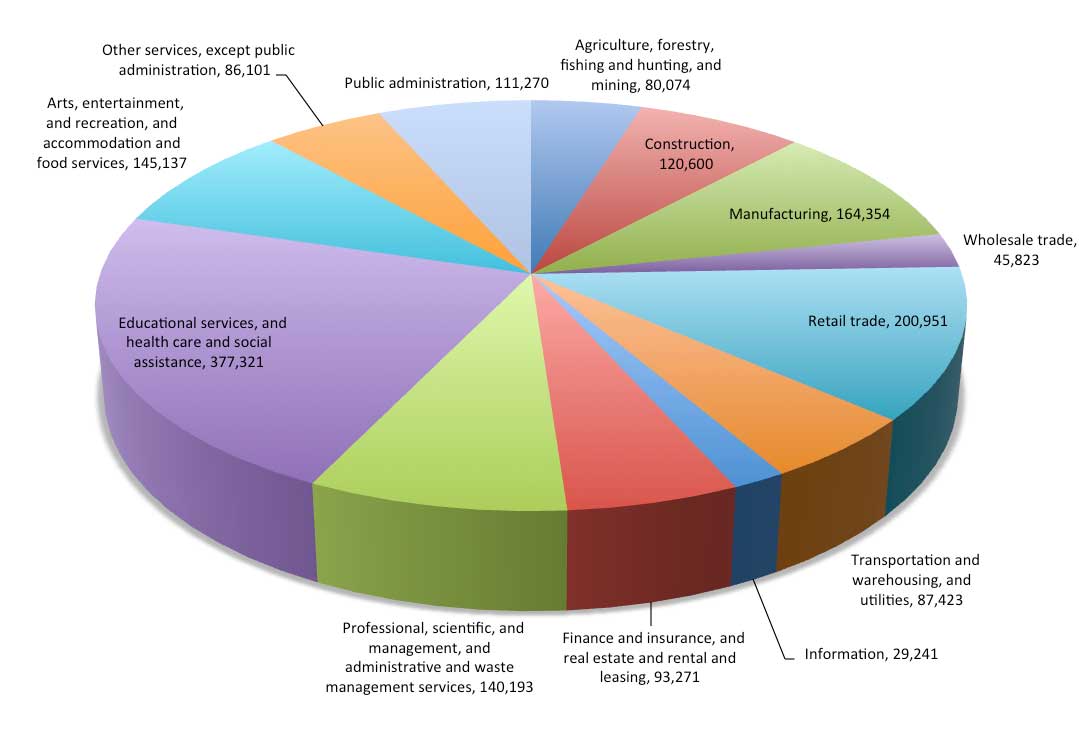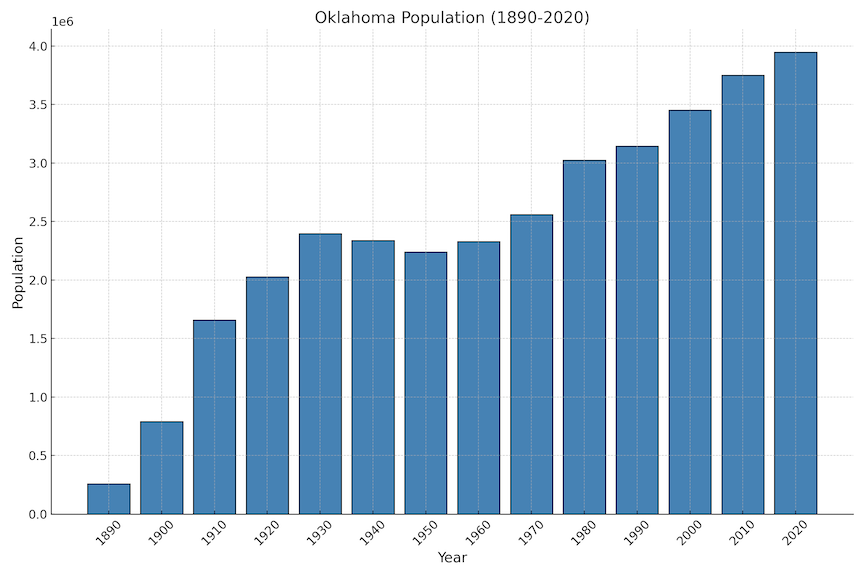Oklahoma


Basic Information
Postal Abbreviation: OK
Natives: Oklahoman
Population 2020: 3,959,353
Legal Driving Age: 16
Age of Majority: 18
Median Age: 36.2
State Song: “Oklahoma”
Lyrics: Richard Rodgers
Music: Oscar Hammerstein
Median Household Income:$51,424
Capital..... Oklahoma City
Entered Union..... Nov. 16, 1907 (46th)
Present Constitution Adopted: 1907
Nickname: Sooner State
Motto:
“Labor omnia vincit”
(Labor conquers all things)
Origin of Name:
Taken from Choctaw Indian words for “red” and “people”.
USS Oklahoma
Railroad Stations
Oklahoma Economy
AGRICULTURE: cattle, cotton, hay,
milk, poultry, wheat, wood.
MINING: coal, gypsum, helium, natural
gas, petroleum, stone.
MANUFACTURING: electric
manufacturing, food processing,
machinery, metal products, petroleum
products, rubber products,
transportation equipment.
![]()

Oklahoma Geography
Total Area: 69,903 sq. miles
Land area: 68,679 sq. miles
Water Area: 1,224 sq. miles
Geographic Center: 8 mi. N of Oklahoma City
Highest Point: Black Mesa
(4,973 ft.)
Lowest Point: Little River
(289 ft.)
Highest Recorded Temp.: 120˚ F (7/26/1934)
Lowest Recorded Temp.: –27˚ F (1/18/1930)
The state is primarily an elevated plain. The Quachita Mountains are located on the southeastern border of the state. In the south rise the Washita Mountains. The hills near the Arkansas border rise to a height of 2500 feet.
Cities
Oklahoma City, 649,021
Tulsa, 400,669
Norman, 110,925
Lawton, 96,867
Broken Arrow, 98,850
Edmond , 81,405
Moore, 55,081
Midwest City, 54,371
Enid, 49,379
Stillwater, 45,688
Oklahoma History
1803 Oklahoma became part of the United States as part of the Louisiana
Purchase. It was placed under the control of the Indian Affairs
administration. Oklahoma became the home of the Indian tribes removed
from east.
1861-65 During the civil war many of Indian tribes sided with the confederacy.
1889 Congress passed a law opening Oklahoma to settlement.
1890 A territorial government was established.
1891 President Benjamin Harrison proclaims that 900,000 acres of Indian land is
now open for public lands.
1907 Oklahoma was admitted to the Union as the 46th state.
1918 Production begin in the oil fields.
1921 Tulsa Race Riot.
1995 The Alfred P Murrah Federal Building was bombed in downtown Oklahoma City killing 168 people
Famous People
L. Gordon Cooper
Owen K. Garriott
Jeane Kirkpatrick
Mickey Mantle
Bill Moyers
Daniel Patrick Moynihan
Tony Randall
Oral Roberts
Will Rogers
Thomas P. Stafford

Oklahoma National Sites
1) ChickasawNational Recreation Area
At Chickasaw National Recreation Area the power of place is evident to even the casual observer: cool creeks flowing over travertine terraces; the silhouette of a great blue heron perched on the shore of the Lake of the Arbuckles; families reuniting in historic campgrounds; local residents coming to fill jugs with mineral water; and the idyllic escape so many find through visits
2) Fort Smtih
From the establishment of the first Fort Smith on December 25, 1817, to the final days of Judge Isaac C. Parker's jurisdiction over Indian Territory in 1896, Fort Smith National Historic Site preserves almost 80 years of history. Explore life on the edge of Indian Territory through the stories of soldiers, the Trail of Tears, dangerous outlaws, and the brave lawmen who pursued them.
3) Oklahoma City National Memorial
On April 19, 1995 Timothy McVeigh parked a Ryder truck outside of the Alfred P. Murrah Federal Building. The Oklahoma City bombing will be remembered as a senseless act of domestic terrorism that took 168 lives and left many changed forever. The Oklahoma City National Memorial & Museum is an affiliated site of the National Park Service, a tribute to the Memorial’s national significance.
4) Washita Battlefield
The site protects and interprets the setting along the Washita River where Lt. Col. George A. Custer led the 7th U.S. Cavalry on a surprise dawn attack against the Southern Cheyenne village of Peace Chief Black Kettle on November 27, 1868. The attack was an important event in the tragic clash of cultures of the Indian Wars era.
 >
>